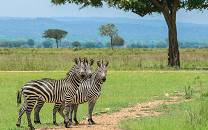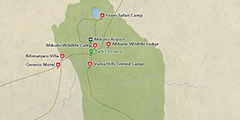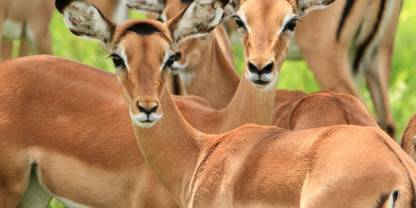Underrated Mikumi National Park is known for its open horizons and abundant wildlife, especially across the Serengeti-like expanses of the Mkata Floodplain. The hippo pool and Millennium area are particularly popular, with good reason. The Dar–Ruaha road bisects Mikumi and it can get busy during the Dry season. To escape the crowds, the park’s south has a wild wilderness feel, and is known for its elephants and lions.

-
Best Time To Go
- Late June to October (Animals are attracted to the waterholes)
-
High Season
- June to October
-
Size
- 3,230km² / 1,247mi²
-
Altitude
-
201-1,143m /659-3,750ft
 View Photos
View Photos
 View Photos
+24
Photos
View Photos
+24
Photos
 Open Map
Open Map
Pros & Cons
- Good general wildlife viewing, including lion, buffalo, elephant and giraffe
- Home to unusual antelope species such as eland, greater kudu and sable
- available
- Excellent well-priced mid-range lodges
- Convenient stopover between Dar es Salaam and Ruaha National Park
- The park’s south promises quieter, wildlife-rich expeditions
- The Tanzam Highway runs straight through the park
- Animals are scattered and more difficult to see during the Wet season
- Some lodges close from March to May
- The park can get busy at weekends
Wildlife
The grasslands of Mikumi support large herds of zebra, wildebeest, buffalo and impala. Giraffe and elephant are also common. Large predators such as lion, leopard and spotted hyena are less conspicuous, but still possible. Watch also for eland, greater kudu, sable and Lichtenstein’s hartebeest. Troops of yellow baboon and vervet monkey are found throughout the park. The planned reintroduction of rhino to Mikumi will only increase the park’s appeal.
More about Mikumi's wildlifeScenery
The main 60km/37mi tourist road circuit on the Mkata River comprises open grassland interspersed with acacia woodland, patches of borassus palms, black hardwood trees and the odd baobab. The park sits in a basin partly encircled by mountains, which provide a pretty backdrop. Around 80% of Mikumi lies south of the Tanzam Highway and is only for well-equipped expeditions.
Activities
The main activity in Mikumi is along the excellent network of wildlife-viewing roads that crisscross the Mkata Floodplain northeast of the Tanzam Highway. These roads and the they pass are perfect for birding and general wildlife viewing; the waterholes in particular often reward those who park alongside them and wait patiently. Other activities include and guided night drives.
Weather & Climate
Mikumi enjoys almost uniform temperatures throughout the year because of its equatorial location. The months of the Dry season (June to October) are among the coolest. The Wet season (November to May) is humid and hot, especially in the closing months of the year.
More about the weather and climateBest Time To Visit
The Dry season runs from June to October and from late June to October is the best time for viewing wildlife. This is when Mikumi’s vegetation thins out, animals are easy to spot and you can expect lots of sunshine. In September and October in particular, there’s a constant stream of animals coming to drink at the waterholes. Animals are more difficult to see in the wetter months, although the birding is good from November to February.
More about the best time to visit



